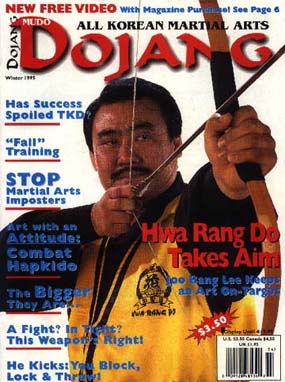

In ancient times, it was the hwa rang who helped to mold
the leaders of a kingdom. In modern times, once again the responsibility to
further develop our youth - the leaders of tomorrow's world - falls on the same
shoulders: the diligent efforts of Hwa Rang Do teachers. In this way, Hwa Rang
Do has come full circle, and will continue so long as the needs exists. At the
forefront of Hwa Rang Do's efforts is Dr. Joo Bang Lee, the 58th generation
of the art's supreme grandmasters. Under his guidence, Hwa Rang Do maintains
its ties to the past, while keeping an eye on the future.
Hwa Rang Do's roots began in 57 B.C., and continued with increasing popularity
for 1500 years, through the Silla dynastic period and the Koryo dynasty. Initially,
organized groups of youths went to the mountains, rivers, and other places of
natural beuaty to learn patience, mental and emotional control, and to study
artistic pursuits and the martial arts. Through the development of strong mental,
physical and spiritual training, these unified groups of youth people were the
predecessors of the hwa rang. Jin Gol and Seong Gol, the children of the royal
families, were chosen to be trained to be the leaders of the kingdom, a kukson
(grandmaster) possessed the rank of general in the military, and the hwa rang
were the leaders and teachers who instructed from 300 to 5000 students.
"The youths of the Silla dynasty learned loyalty to their country; so they
were able to make one kingdom, and it lasted one thousand years, and the kingdom
grew," Dr. Lee notes. "That is also the modern way; a generation that
is training today must repeat those same Hwa Rang Do rules."
Those rules were encapsulated in 540 A.D. when the Buddist monk Won Kwan Bopsa
gave two hwa rang named Kwi San and Chu Hang a code of ethical behavior by which
they should live their lives. The Hwa Rang Do Meng Sae (Hwa Rang Do's
Code of Ethics) or Hwa Rang O Kae (Hwa Rang Five Rules) is still taught
to all Hwa Rang Do practitioners today, and includes loyalty to one's country,
loyalty to one's parents and teachers, trust and brotherhood among friends,
courage never to retreat in the face of an enemy, and justice never to take
a life without cause. the Hwa Rang Kyo Hoon (Hwa Rang Nine Virtues) are:
humanity, justice, courtesy, wisdom, trust, goodness, virtue, loyalty, and courage.
"That is how I was trained," says Dr. Lee,"and that's how I am
teaching the next generation too. Young people must be taught good habits. A
martial arts trainer, especially a Hwa Rang Do instructor, is a 'parent' in
that way. They groom the children in the ways of respect, loyalty. After the
Hwa Rang Do five rules, after training, they learn that this is a very good
way to live their lives. So after they learn, they strictly follow those rules.
"Hwa Rang Do is over two thousand years old, passed down by secret ways,"
says Dr. Lee. "But other modern martial arts are mostly sports-like - which
means no more martial art. Those students just come in, practice, sweat, go
home, and that's it. They have the fist and foot as weapons, but they might
not be used correctly: It's easy to use for hitting somebody, and this country
has laws so that if you're hitting somebody, you can go to jail. The duty of
instructors is very heavy; the first concern is training in ethics."
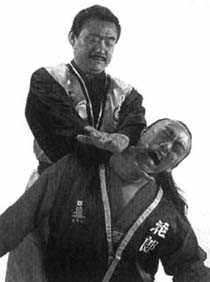
But there is more to Hwa Rang Do history than its ethical precepts.
From 540 A.D. to 570 A.D., King Chinhung incorporated the hwa rang into his
military service; they fought for the Silla kingdom against the sovereign of
the two neighboring kingdoms of what are now known as Korea, Paekche and Koguryo.
The ferocious spirit of the Hwa Rang warriors became legendary, with history
documenting literally thousands of instances concerning their heroic deeds.
Known as gentlemen of high intelligence, they were concurrently feared as the
fiercest fighting sect of all Asia. The adherence to their strict martial code
of chivalry, coupled with superlative fighting techniques, made them the major
driving force behind the first unification of the Korean Peninsula: the Unified
Silla Dynasty.
During the Yi dynasty (1392-1910), Buddhism was replaced by Confucianism as
the state religon. As a result, martial artists were in disfavor with the ruling
forces; they went to the mountains where a few monks continued teaching select
students in a continual chain leading to the 57th generation supreme grandmaster,
Suahm Dosa, who started teaching his two disciples, Joo Bang Lee and his brother
Joo Sang Lee, in 1942 at the So Gwang Sa Temple in North Korea.
In 1948, the Lee family and Suahm Dosa emigrated to South Korea, where Suahm
Dosa took up residence on O Dae Mountain at the Yang Mi Ahm Temple, continuing
to train the brothers.
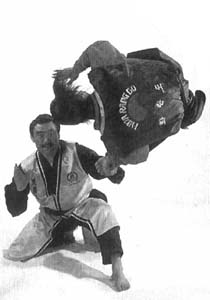 But this was not Joo Bang Lee's only martial arts instruction. In addition to
Hwa Rang Do, he also studied boxing, judo, kendo and Korean kenpo; in 1955,
the brothers attained master level in Dae Dong Ryu Yu Sul - later renamed hapkido
- from the style's founder, Yong Sool Choi, with whom they received private
instruction.
But this was not Joo Bang Lee's only martial arts instruction. In addition to
Hwa Rang Do, he also studied boxing, judo, kendo and Korean kenpo; in 1955,
the brothers attained master level in Dae Dong Ryu Yu Sul - later renamed hapkido
- from the style's founder, Yong Sool Choi, with whom they received private
instruction.
Joo Bang Lee opened the first public school of Hwa Rang Do in 1960, in Chong
Ryo, Seoul, South Korea.
In 1962, the Lee brothers founded the Korean Martial Arts Association. Initial
members included Uoo Tack Kim, a Yu Sul and hapkido practitioner who later changed
to Kuk Sul Kwan; Han Chul Lee, a practitioner of Yu Sul and hapkido, who later
changed to Bul Mo Do; Il Woong Huh, a hapkido practitioner; In Hyuk Suh, of
Ship Pal Kye and hapkido, who later changed to Kuk Sool Won; and Moo Jin Him,
a Yu Sul and hapkido practitioner who later changed to Ho Shin Do. In December
of that year, the KMAA and the Korean Hwa Rang Do Association opened their headquarters
in Seoul, and in January, 1963, the KMAA opened its Pusan headquarters overseen
by Han Chul Lee and In Hyuk Suh. However, due to conflicts within the association,
it was disbanded in 1966, and the original members started their respective
organizations.
In 1968, the Korean government officially recognized the Korean Hwa Rang Do
Association. Having made additional attempts in the previous two years to unify
Korean martial arts, Dr. Joo Bang Lee now concentrated his efforts solely on
Hwa Rang Do's development, overseeing 68 schools in the nation. That same year,
Head Grandmaster Joo Sang Lee introduced Hwa Rang Do to the United States, and
Joo Bang Lee founded the World Hwa Rang Do Association. Joo Bang Lee became
the system's supreme grandmaster upon Suahm Dosa's death in 1969, and emigrated
to the United States in 1972.
Subsequent to its founding, more than 500 masters and 2000 instructors have
been taught under the jurisdiction of the World Hwa Rang Do Association, and
this sense of unity and continuance is central to the style's philosophy.
"Since I opened a school in Korea," notes Dr. Lee,"we have more
than 200 branches in America; worldwide, there are about 400 branches, each
with about 500 students. Many of our students have experience in other martial
arts, such as tae kwon do, karate, or kung fu, and they come in and see
Hwa Rang Do and they love it. Even other instructors who have a school change
to Hwa Rang Do. But when they come to Hwa Rang Do, they must be strictly loyal
to Hwa Rang Do: teaching only Hwa Rang Do, and even displaying only a Hwa Rang
Do sign. That is the martial arts, to have life-long loyalty to their style.
Maybe some began training in another martial art because the school was close
to their home; then they decided they wanted a more advanced martial art. Of
course, because they have experience, it is easier for them to learn Hwa Rang
Do."
Based on the emphasis he places on loyalty, it is not surprising that Dr. Lee
says he's "not as concerned about Hwa Rang Do growing larger - about how
many schools we have; I'm concerned about how solid the Hwa Rang Do family is.
Other styles have thousands of organizations; Hwa Rang Do has only one organization
in the world."
Both a martial art and a healing art, Hwa Rang Do is one of
the most diversified yet comprehensive martial arts systems. Designed for all
types of people, it integrates the mental and physical in a way that enables
practitioners to realize their full potential.
The moo sul (martial aspects) of Hwa Rang Do can be divided into four
major paths of study:
Nae Gong, for example, deals with developing, controlling, and directing
one's ki, or inner energy force, through breathing and meditation exercises
in conjuction with specific physical techniques. Due to the exercises' internal
nature, they demand superior patience and concentration. Hwa Rang Do practitioners
learn to develop, harness, and apply this human energy resource at will, making
the body light, strong, oblivious to pain, and faster than would otherwise be
possible. Initially studied to make the individual healthy, at more advanced
stages this power can be controlled in conjunction with the thought processes
and be transmitted from one individual to another for combative and healing
applications.
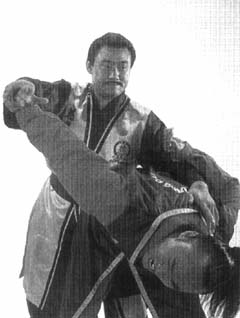 Wae gong includes more than 4000 offensive and defensive combative applications.
Combining elements predominantly tense and linear in nature with those soft
and circular, these techniques mesh to form a natural fighting system. This
phase includes full instruction in all hand strikes and blocks, 365 individual
kicks, throws and falls from any position and onto any surfaces, human anatomical
structure as it pertains to combat applications, joint manipulation and breaking,
finger pressure-point application, prisoner arrest, control and transport, forms,
offensive choking and flesh-tearing techniques, defense against multiple opponents,
breaking techniques, counter-attacks, and killing techniques.
Wae gong includes more than 4000 offensive and defensive combative applications.
Combining elements predominantly tense and linear in nature with those soft
and circular, these techniques mesh to form a natural fighting system. This
phase includes full instruction in all hand strikes and blocks, 365 individual
kicks, throws and falls from any position and onto any surfaces, human anatomical
structure as it pertains to combat applications, joint manipulation and breaking,
finger pressure-point application, prisoner arrest, control and transport, forms,
offensive choking and flesh-tearing techniques, defense against multiple opponents,
breaking techniques, counter-attacks, and killing techniques.
These applications are taught in their combative form, yet with full control,
to minimize any danger to the student. By practicing these diverse aspects,
practitioners become healthy through exercise while simultaneously learning
to contain and control any antagonist within one movement.
Moo gi gong deals with the offensive and defensive use of 108 individual
weapons found within 20 weaponry categories. By learning these weapon systems,
the advanced practitioner can effectively use any available object as a weapon.
Shin gong involves the study, development, and control of the human mind
to attain one's full potential and mental capabilities. Included are techniques
to increase awareness and concentration levels, clairvoyance and development
of the sixth sense, the natural laws of the universe, the study of human types,
visualizations, and the arts of concealment and stealth.
But "Hwa Rang Do is not just about the martial arts technique," says
Dr. Lee. In Sul, the study of the Oriental healing arts, requires students
to become one with the natural laws of the universe, including the more intricate
level of healing injuries and disease. To effectively defend himself, the practitioner
develops the capacity to heal himself as well as others. First-aid applications
and revival techniques are taught to black belt students in conjunction with
traditional acupuncture, royal family acupressure, herbal and natural medicines,
and bone-setting.
According to Dr. Lee,"Nine universities have Hwa Rang Do clubs. The next
step is to make a hospital with a university, Oriental medicine, and Hwa Rang
Do. Hwa Rang Do studies human weaknesses and vital points. If someone is learning
how to kill people, they must learn how to heal people too. The main way of
training is not only for self defense; when you take out, you must learn how
to put back, too."
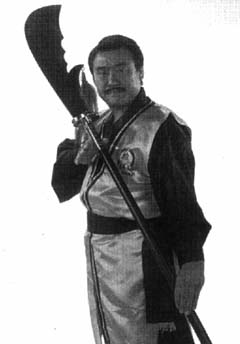 HUMANITY'S
HOPE
HUMANITY'S
HOPELearning to give back is the underlying current in Hwa Rang
Do's efforts to train the youth of the next generation, as was done so many
centuries ago in the Silla kingdom. Proper instruction in all aspects of life
is integral to a child's development - not merely to survive, but to flourish
and build for subsequent generations as well. While traditionally Hwa Rang Do
was taught to the youth of Korean nobility to make them strong leaders, in the
modern times, this versitile art is available to anyone who aspires to enhance
his life and have a positive impact on society.
In all Hwa Rang Do dojang, masters and instructors insist on knowing how their
young charges are progressing academically, at home, and in their social development.
Class homework sessions are even held on a regular basis before physical training
to assist the students. The code of ethics found in Hwa Rang Do is the cornerstone
of this martial and healing art, and strict adherence to its values is of paramount
concern. Perseverance in the face if life's adversities requires more than merely
coping with its trials and tribulations. A martial artist must learn to savor
each moment and to learn from setbacks. A positive attitude is crucial in forming
esteem, confluence and feelings of self-worth in the young people.
"Of course Eastern philosophy is geared toward family and defending the
country," Dr. Lee notes. "We're teaching children loyalty and how
to respect the parents; then the children go home and practice that way.
"People today have much more freedom. In some ways that's good, but in
other ways it's not so good. When children are joining, for instance, I talk
with their parents, and explain that the Hwa Rang Do master is like a parent.
Sometimes a Hwa Rang Do master might give out a punishment, and the child wants
to drop, because he is only in the class for enjoyment. I express concern to
parents; they must know that the instructor is a strict trainer. Sometimes if
the child says,'I don't want to go to Hwa Rang Do school,' the parent will say,'Okay,
if you don't want to go, don't go.' That is using very bad judgement; it makes
it easy for the child to drop things throughout his life. This is too much freedom."
Since most public (and many private) school systems suffer from overcrowding
and from an inability of the teachers to adequately control the class - much
less instill knowledge in all their students - it is the collective responsibility
of the child's parents, teachers and martial art instructors to develop the
student into the most productive person that he or she can be. To this end,
the World Hwa Rang Do Association has implemented specialized programs to assist
inner city and underprivileged youths, helping them to become free of gangs
and drugs, in cooperation with various community programs. Too much free time,
"latch-key kids," and in some cases, blatant parental apathy can cause
the children to choose the wrong paths in life.
"If they cannot handle them, we handle them," states Dr. Lee. "When
young people first join Hwa Rang Do, they train in respect. Some other martial
arts are just for sports, to 'win.' Hwa Rang Do mostly teaches the philosophical
way of life. There is not much difference between how it was taught long ago,
and how it is taught now.
"I want to pass this on to the 59th generation," says Dr. Lee,"so
that Hwa Rang Do will continue for two thousand years more."